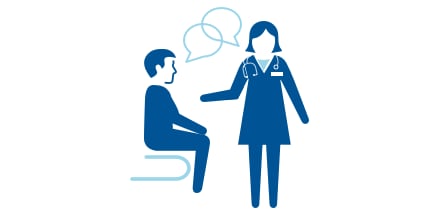Purpose
Use these Think. Test. Treat TB messages for general audiences to increase awareness of inactive tuberculosis (TB) and encourage testing and treatment.

How to Think, Test, and Treat TB
Think. Am I at risk for TB infection?
Anyone can get TB, but you might have a higher risk for TB if you:
- Were born in or frequently travel to countries where TB is common, including some countries in Asia, Africa, and Latin America
- Live or used to live in large group settings where TB is more common, such as homeless shelters, prisons, or jails
- Recently spent time with someone who has active TB disease
- Have a weaker immune system because of certain medications or health conditions such as diabetes, cancer, and HIV
- Work in places where TB is more likely to spread, such as hospitals, homeless shelters, correctional facilities, and nursing homes
Test. What TB test is needed?
The CDC recommends that people that are at increased risk should be tested for TB.
There are two types of tests:
TB blood test
The blood test measures how your immune system reacts to the germs that cause TB. If you have ever received a vaccine for TB, your healthcare provider will recommend that you have the TB blood test.
TB skin test
For the skin test, a small needle is used to put some testing material under the skin. You will need to return to your healthcare provider in 2-3 days to see if there is a reaction.
Treat. What are the treatment options?
If you have inactive TB, treating it is the best way to protect you from getting sick with active TB disease. There are several short and convenient treatment options available.
Key Messages
TB Statistics
- Tuberculosis (TB) is one of the world's leading infectious disease killers.
- Up to 13 million people in the United States have inactive TB, also known as latent TB infection.
TB Risk
- TB germs are spread through the air when someone with active TB disease coughs, talks, or sings. People nearby may breathe in the TB germs and become infected.
- TB can live in your body for years without symptoms but can become active anytime and make you sick. This is called inactive TB or latent TB infection.
- You may be at risk for TB even if you have received the TB vaccine (also called the BCG vaccine) because its protection weakens over time.
- It's important to talk with your health care provider about your risk for TB.
TB Testing and Treatment
- Without treatment, 1 in 10 people with inactive TB will get sick with active TB disease, which can spread to others and be deadly.
- More than 80% of people who get sick with active TB disease in the United States each year get sick from long-standing, untreated inactive TB, which can develop into active TB disease years or even decades later.
- Inactive TB can be treated to prevent active TB disease. Short and convenient treatments are available that can help protect you and your loved ones from getting sick.
- Public and private healthcare plans may cover the costs of testing and treatment for TB infection.
- Talk to your doctor about testing for TB to protect yourself, your family and friends, and your community.
- Inactive TB can be treated to prevent active TB disease. Short and convenient treatments are available that can help protect you and your loved ones from getting sick.
